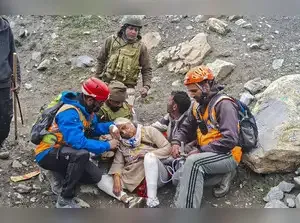The Indian Army has launched Operation Shiva as part of a multi-tier security setup to secure the ongoing Amarnath Yatra deploying 8,500 troops and a counter-unmanned aerial system (C-UAS) grid on the twin routes to the cave shrine, an official on Friday said.
The 38-day pilgrimage to the 3,880-metre-high shrine commenced on July 3 from the valley via twin tracks - the traditional 48-kilometre-long Nunwan-Pahalgam route in Anantnag district and the 14-kilometre shorter but steeper Baltal route in Ganderbal district. The yatra will conclude on August 9.
"The Indian Army has launched Operation Shiva in close coordination with the civil administration and Central Armed Police Forces (CAPFs) to ensure the smooth and secure conduct of the Amarnath Yatra," said a defence spokesperson.
The spokesperson said this annual high-tempo operation aims to provide a robust security architecture along both the northern and southern yatra routes, particularly in light of the heightened threat from Pakistan-backed proxies in the aftermath of Operation Sindoor.
"As part of this year's enhanced security framework, over 8,500 troops have been deployed, supported by a wide array of technological and operational resources," he added.
The spokesperson asserted it is part of a multi-tier security setup, a dynamic counter-terrorism grid, prophylactic security deployment and corridor protection measures have been instituted.
"Comprehensive assistance to civil authorities is also being provided, particularly in disaster management and emergency response," he said.
Spelling out key deployments and tasks under Operation Shiva, the spokesperson said that a counter-UAS grid with more than 50 C-UAS and electronic warfare (EW) systems has been put in place to neutralise drone threats apart from regular UAV missions and live monitoring of the yatra routes and the holy cave.
He further said that engineer task forces have also been deployed for bridge construction, track widening and disaster mitigation, with more than 150 doctors and medical personnel, two advanced dressing stations, nine medical aid posts, a 100-bed hospital and 26 oxygen booths supported by 2,00,000 litres of oxygen.
In addition, signal companies for seamless communication, EME detachments for technical support and bomb detection and disposal squads have been put in place along with emergency rations for 25,000 persons, QRTs, tent cities, water points and plant equipments, including bulldozers and excavators.
"Indian Army helicopters remain on standby for any contingency response," said the spokesperson, adding the Army is harnessing advanced technology to ensure a robust security framework during the ongoing Amarnath Yatra.
"By implementing live tracking of yatra convoys between Jammu and the holy cave, the Army is maintaining constant situational awareness through high-resolution PTZ camera and drone feeds. Real-time updates on convoy movement are being monitored to pre-empt any threats, while seamless multi-agency coordination ensures swift response and effective security management across the entire route," he said.
Operation Shiva reflects the Indian Army's unwavering commitment to ensure a safe, seamless, and spiritually fulfilling yatra for all devotees undertaking the sacred pilgrimage, the spokesperson added.
Over 1.40 lakh pilgrims have paid obeisance to the ice lingam of Lord Shiva. More than four lakh persons have registered online for the pilgrimage so far.
Over 5.10 lakh pilgrims paid obeisance last year at the cave shrine, which houses a naturally formed ice lingam.
The 38-day pilgrimage to the 3,880-metre-high shrine commenced on July 3 from the valley via twin tracks - the traditional 48-kilometre-long Nunwan-Pahalgam route in Anantnag district and the 14-kilometre shorter but steeper Baltal route in Ganderbal district. The yatra will conclude on August 9.
"The Indian Army has launched Operation Shiva in close coordination with the civil administration and Central Armed Police Forces (CAPFs) to ensure the smooth and secure conduct of the Amarnath Yatra," said a defence spokesperson.
The spokesperson said this annual high-tempo operation aims to provide a robust security architecture along both the northern and southern yatra routes, particularly in light of the heightened threat from Pakistan-backed proxies in the aftermath of Operation Sindoor.
"As part of this year's enhanced security framework, over 8,500 troops have been deployed, supported by a wide array of technological and operational resources," he added.
The spokesperson asserted it is part of a multi-tier security setup, a dynamic counter-terrorism grid, prophylactic security deployment and corridor protection measures have been instituted.
"Comprehensive assistance to civil authorities is also being provided, particularly in disaster management and emergency response," he said.
Spelling out key deployments and tasks under Operation Shiva, the spokesperson said that a counter-UAS grid with more than 50 C-UAS and electronic warfare (EW) systems has been put in place to neutralise drone threats apart from regular UAV missions and live monitoring of the yatra routes and the holy cave.
He further said that engineer task forces have also been deployed for bridge construction, track widening and disaster mitigation, with more than 150 doctors and medical personnel, two advanced dressing stations, nine medical aid posts, a 100-bed hospital and 26 oxygen booths supported by 2,00,000 litres of oxygen.
In addition, signal companies for seamless communication, EME detachments for technical support and bomb detection and disposal squads have been put in place along with emergency rations for 25,000 persons, QRTs, tent cities, water points and plant equipments, including bulldozers and excavators.
"Indian Army helicopters remain on standby for any contingency response," said the spokesperson, adding the Army is harnessing advanced technology to ensure a robust security framework during the ongoing Amarnath Yatra.
"By implementing live tracking of yatra convoys between Jammu and the holy cave, the Army is maintaining constant situational awareness through high-resolution PTZ camera and drone feeds. Real-time updates on convoy movement are being monitored to pre-empt any threats, while seamless multi-agency coordination ensures swift response and effective security management across the entire route," he said.
Operation Shiva reflects the Indian Army's unwavering commitment to ensure a safe, seamless, and spiritually fulfilling yatra for all devotees undertaking the sacred pilgrimage, the spokesperson added.
Over 1.40 lakh pilgrims have paid obeisance to the ice lingam of Lord Shiva. More than four lakh persons have registered online for the pilgrimage so far.
Over 5.10 lakh pilgrims paid obeisance last year at the cave shrine, which houses a naturally formed ice lingam.








